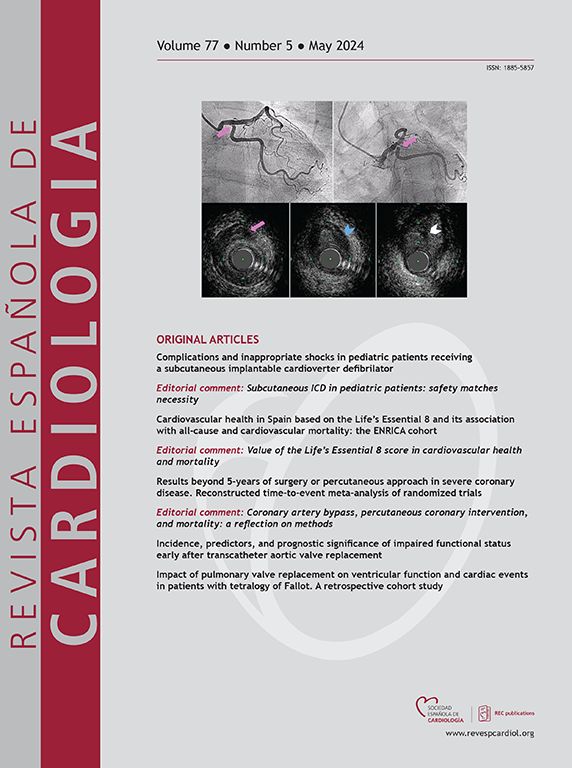冠状动脉扭曲对新一代药物活性支架植入结果的影响:BIOFLOW随机研究分析
IF 5.9
2区 医学
Q2 Medicine
引用次数: 0
摘要
介绍和目的对中度至重度扭曲血管进行经皮冠状动脉介入治疗的患者有较高的不良后果风险,但在新一代支架时代,相关数据很少。我们比较了使用生物可吸收聚合物西罗莫司洗脱支架(BP-SES)和耐用聚合物依维莫司洗脱支架(DP-EES)对中度至重度扭曲血管进行经皮冠状动脉介入治疗的结果。方法将来自BIOFLOW II、IV和V随机试验的2350例患者根据靶血管扭曲程度分为2组:无至轻度和中度至重度。主要终点包括靶病变衰竭(TLF)——心源性死亡、靶血管心肌梗死(TV-MI)或缺血驱动的靶病变血运重建术(TLR)——以及3年时可能/确定的支架血栓形成。结果中重度扭曲患者(903例)的合并症发生率高于无至轻度扭曲患者(1447例)。两组间TLF (P = 0.354)、心源性死亡(P = 0.690)、TLR (P = 0.447)和支架内血栓形成(P = 0.084)发生率相似,而TV-MI在中重度扭曲组发生率更高(P = 0.031)。然而,在多变量分析中,中度至重度扭曲并不是TV-MI的独立预测因子(调整后HR, 1.06;95% ci, 0.72-1.55;p = .772)。在中重度扭曲患者中,与DP-EES相比,BP-SES的使用与TLF发生率显著降低相关(7.8% vs 13.4%;人力资源,0.57;95% ci, 0.37-0.87;P = 0.009),由TV-MI降低所致(5.0% vs 9.2%;人力资源,0.54;95% ci, 0.32-0.90;P = 0.018)和TLR (2.7% vs 6.1%;人力资源,0.45;95% ci, 0.23-0.90;p = .021)。结论:对随机BIOFLOW试验的汇总分析表明,无至轻度和中度至重度扭曲患者的长期不良事件发生率相当。然而,在中度至重度扭曲患者中使用BP-SES可能有助于减轻潜在的缺血性风险。临床试验注册:Clinicaltrials.gov NCT01356888, NCT01939249, NCT02389946。本文章由计算机程序翻译,如有差异,请以英文原文为准。
Impacto de la tortuosidad de las arterias coronarias en los resultados del implante de stent farmacoactivo de nueva generación: un análisis de los estudios aleatorizados BIOFLOW
Introduction and objectives
Patients undergoing percutaneous coronary intervention in vessels with moderate-to-severe tortuosity are at higher risk of adverse outcomes, but data are scarce in the era of newer-generation stents. We compared outcomes following percutaneous coronary intervention in vessels with moderate-to-severe tortuosity using a bioresorbable-polymer sirolimus-eluting stent (BP-SES) vs a durable-polymer everolimus-eluting stent (DP-EES).
Methods
A total of 2350 patients from the BIOFLOW II, IV, and V randomized trials were stratified into 2 groups based on target-vessel tortuosity: none-to-mild and moderate-to-severe. The primary endpoints included target lesion failure (TLF)—a composite of cardiac death, target-vessel myocardial infarction (TV-MI), or ischemia-driven target lesion revascularization (TLR)—and probable/definite stent thrombosis at 3 years.
Results
Patients with moderate-to-severe tortuosity (n = 903) had more comorbidities than those with none-to-mild tortuosity (n = 1447). Rates of TLF (P = .354), cardiac death (P = .690), TLR (P = .447), and stent thrombosis (P = .084) were similar between the 2 groups, whereas TV-MI occurred more frequently in the moderate-to-severe tortuosity group (P = .031). However, on multivariate analysis, moderate-to-severe tortuosity was not an independent predictor of TV-MI (adjusted HR, 1.06; 95% CI, 0.72-1.55; P = .772). Among patients with moderate-to-severe tortuosity, the use of BP-SES was associated with significantly lower rates of TLF compared with the DP-EES (7.8% vs 13.4%; HR, 0.57; 95% CI, 0.37-0.87; P = .009), driven by reductions in TV-MI (5.0% vs 9.2%; HR, 0.54; 95% CI, 0.32-0.90; P = .018) and TLR (2.7% vs 6.1%; HR, 0.45; 95% CI, 0.23-0.90; P = .021).
Conclusions
This pooled analysis of the randomized BIOFLOW trials demonstrates that patients with none-to-mild and moderate-to-severe tortuosity have comparable long-term adverse event rates. However, the use of BP-SES in patients with moderate-to-severe tortuosity may help mitigate potential ischemic risks.
Clinical trial registration: Clinicaltrials.gov NCT01356888, NCT01939249, NCT02389946.
求助全文
通过发布文献求助,成功后即可免费获取论文全文。
去求助
来源期刊

Revista espanola de cardiologia
医学-心血管系统
CiteScore
4.20
自引率
13.60%
发文量
257
审稿时长
28 days
期刊介绍:
Revista Española de Cardiología, Revista bilingüe científica internacional, dedicada a las enfermedades cardiovasculares, es la publicación oficial de la Sociedad Española de Cardiología.
 求助内容:
求助内容: 应助结果提醒方式:
应助结果提醒方式:


